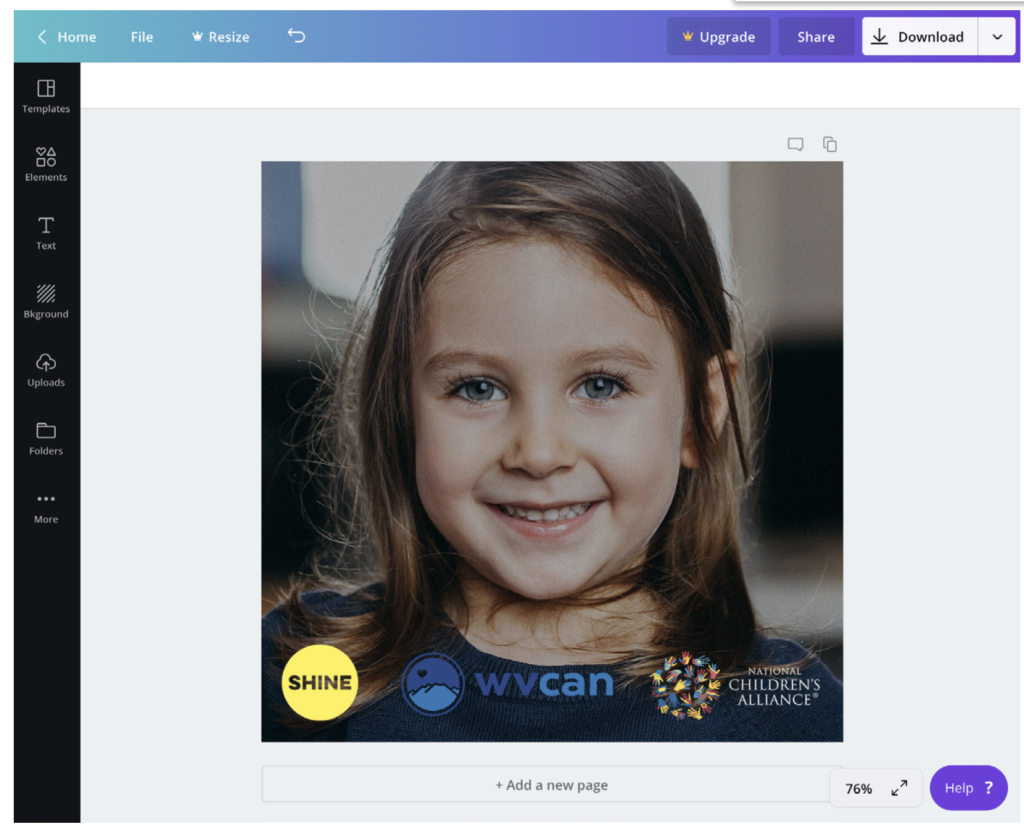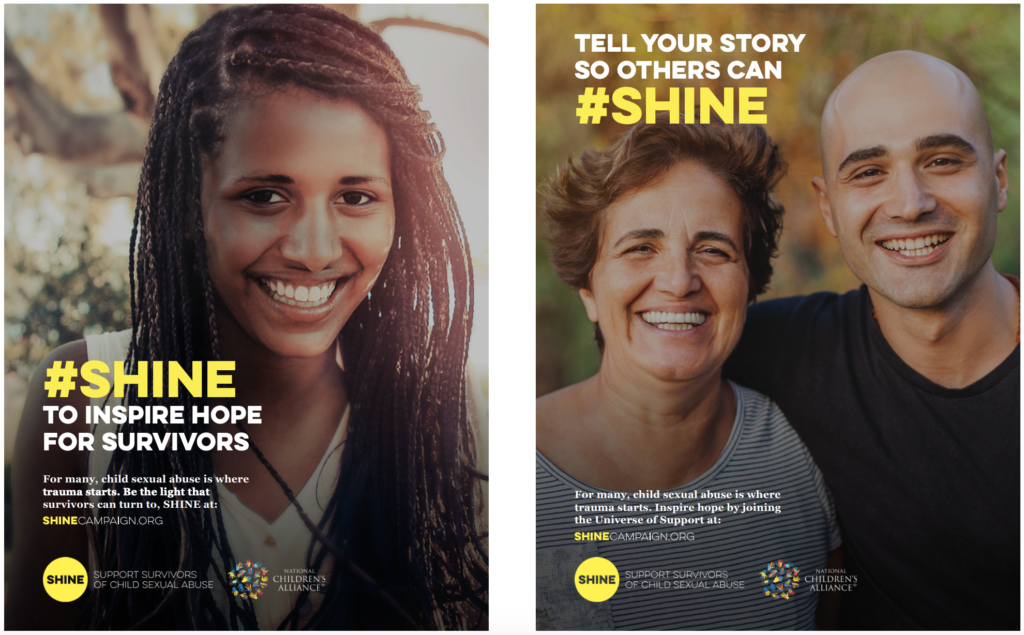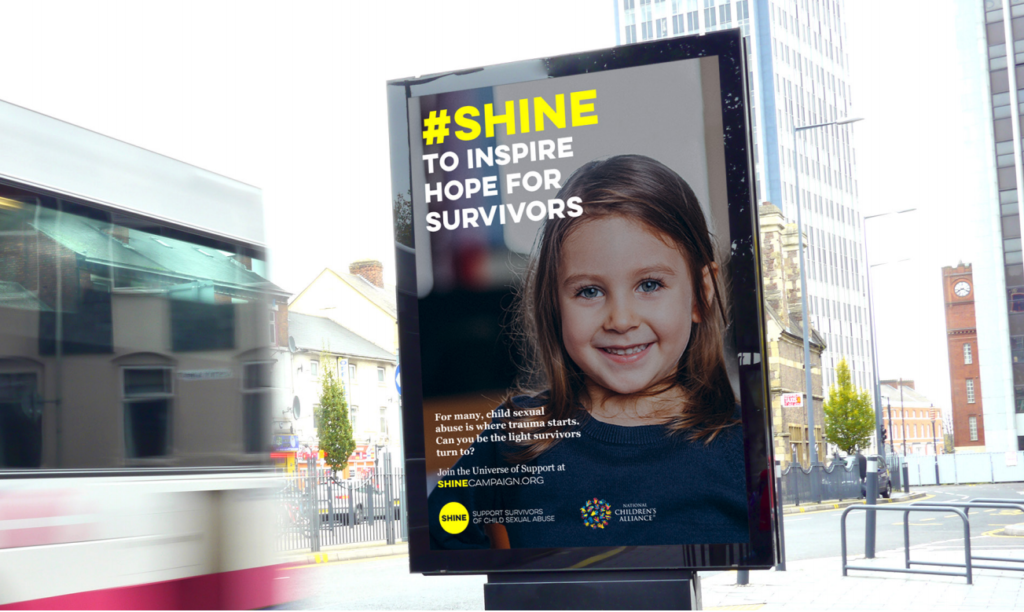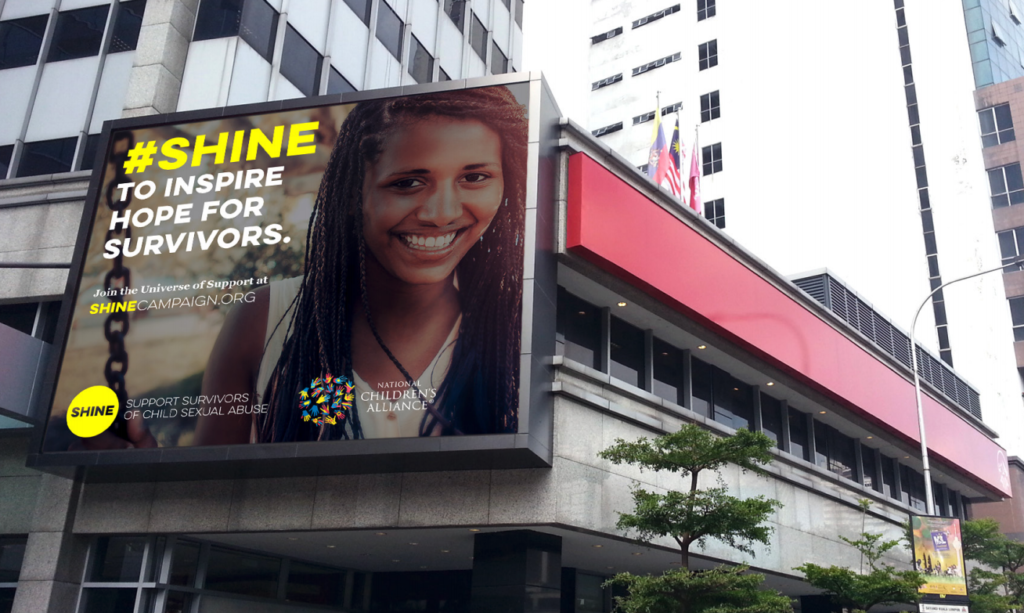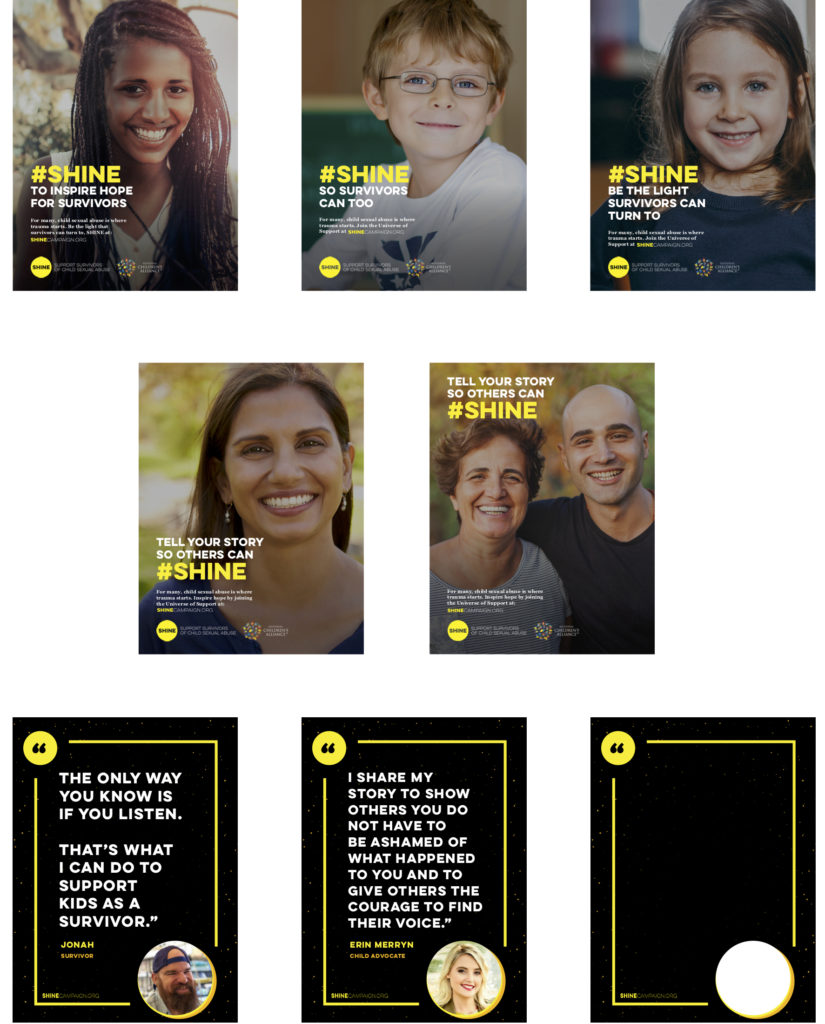
Download this toolkit as a PDF
Introduction
Alone, survivors of child abuse are like stars, single points of light in the darkness. But as each one finds their community, builds visibility, and shares their common commitment to support victims and survivors, they can connect into constellations and galaxies, forming a Universe of Support lighting the way toward a brighter future.
CACs: the heart of our universe of support
SHINE begins with Children’s Advocacy Centers and their state Chapters. Chapters are the organizing force for CACs at the state level and have the opportunity to build a unified, statewide movement for survivors through their member CACs. We want to reach survivors and their allies with this message, because they are many, and because so few know that there is hope. But our work begins with you: the Chapters and CACs who are the shape of that hope.
Your member CACs face a special challenge: Our model is complicated to explain. No matter how sharp we have our elevator pitch down—in a communications landscape where we are vying for the audience’s attention against everything from a 15-minute global news cycle to targeted ads for hot sauce—we have to find a simple, unifying, short message to get the attention of our audience. Once we have their hearts, they have a lifetime to learn about our work.
Our end goal will always be to drive support to and awareness of the CAC movement, which provides healing and justice to hundreds of thousands of kids each year. But to reach this audience, we have to start from the perspectives of survivors who either haven’t heard of us or haven’t heard from us for years.
WHAT’S IN THE TOOLKIT?
This toolkit is your one-stop shop on participating in the SHINE Campaign and building our universe of support through the year-one pilot period. Sections in this toolkit will provide you with ready-to-use strategies, samples, and examples.
A CAMPAIGN FOR EVERY CHAPTER
We believe every Chapter is capable of being a star and gathering other stars in communities around the country to form the constellations that will make up the Universe of Support.
That said, not every one of your members has the same level of funding, communications resources, free staff time, comfort, or experience running public awareness campaigns. This is one of your many roles as the statewide first responder to the needs of your members.
Here are some reasons for and opportunities found in running SHINE as a statewide campaign through your Chapter:
- Your Chapter has the opportunity to make buys for media and physical assets more affordable and the message more unified than CACs can do on their own.
- Your Chapter can coordinate campaigns efficiently by creating ready-made resources, whereas CACs on their own may find this overwhelming.
- Part of your role as a Chapter is to support branding, marketing, and public awareness among many functions. This is an easy way to provide a needed member service and demonstrate your value as the conduit to the nationwide and even global movement.
- You may be able to get help for all of your local CAC members from your members with communications strengths. All for one!
- Chapters can pursue collaborative fundraising strategies to support themselves and their members with a number of new tools on the market.
- Your locals can help identify a statewide spokesperson who may want a larger campaign footprint.
While the aim of this toolkit is to provide you with ready-made resources to help you implement this campaign cheap or free right out of the gate, we want to make sure
that all CACs big and small, nationwide, urban, suburban, or rural find achievable, impactful steps they can take right now to make SHINE work for their CAC and be part of the change we’re all working toward. Chapters will often be the key to success in that effort.
We’ve created three tiers of partnership for CACs and other related organizations
to participate in SHINE: SHINE, Star, and Constellation. SHINE Partnership is the easiest and most approachable level, appropriate for individuals and CACs with very light communications experience and capabilities, while Constellation Partners will implement the campaign in a custom, complex way that makes the most of their resources and connections.
We expect that most CACs will participate at the middle Star Partner level. While there aren’t any set costs or rewards to participating at any given level, we’ve created them to give you a sense of the commitment each level will require for CACs to benefit from the time and resources they spend on participating. Here are the three levels and what it takes to participate at each:
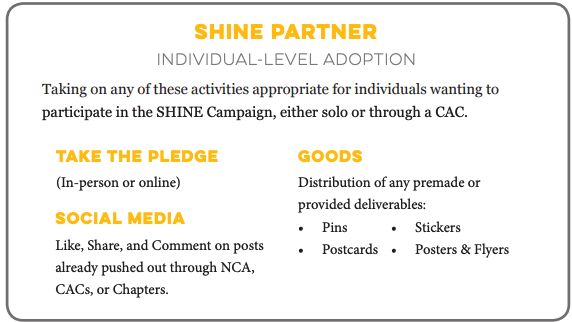
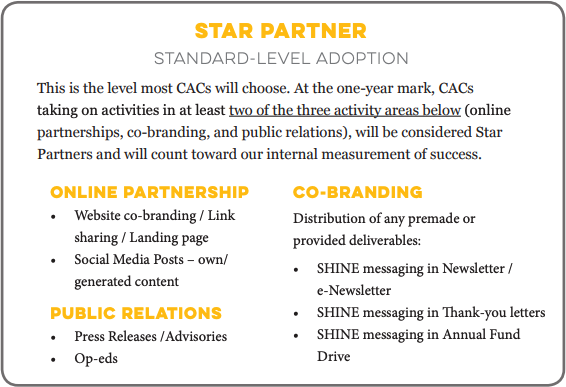
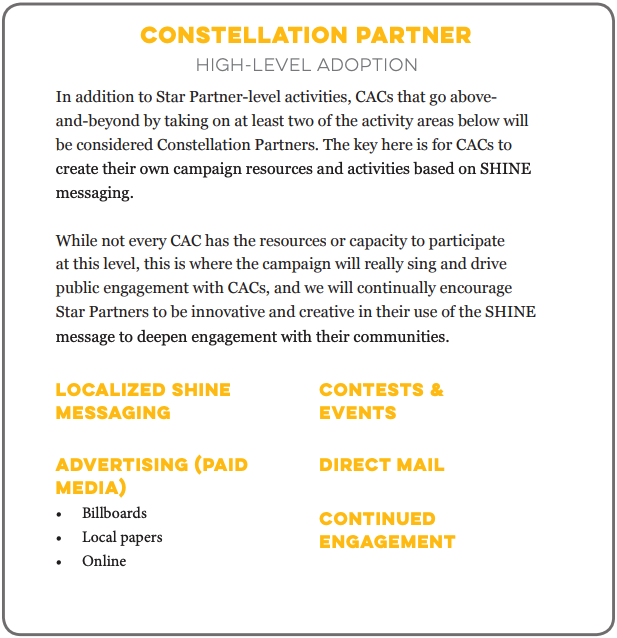
Messaging
In this section, we’ll cover the key messaging of the SHINE Campaign, how we’ll use it, and why. Specific messages or designs will appear in sections related to their media (e.g. messages for social media will appear in that section).
Let’s start with the tone of the campaign which informs everything else. If any message we have here or that we come up with doesn’t align with our tone, we need to rethink it.
CAMPAIGN TONE
The SHINE Campaign tone helps us achieve our goals: ending the stigma around child sexual abuse, inspiring child advocates, and supporting survivors.
- Hopeful
- Bright
- Honest
- Optimistic
- Inclusive
- Compassionate
YEAR ONE MESSAGES: CHILD SEXUAL ABUSE
During the first year of the three-year campaign, SHINE messaging centers around the issue of child sexual abuse. While all abuse is challenging to talk about, child sexual abuse carries the most stigma. The benefit of launching the SHINE Campaign with a specific focus on child sexual abuse allows the campaign to address abuse more generally and expand in scope over time.
Fact
Child sexual abuse exists in the shadow of shame and secrecy.
Supportive
At a time when disclosures of sexual abuse and ha- rassment are mainstream, survivors of child sexual abuse need to know that they can come out of the shadows.
Message
For many, child sexual abuse is where trauma starts.
Action
SHINE Be the light that survivors can turn to
SHINE to inspire hope for survivors
Tell your story so that others can SHINE
You can inspire hope by joining the Universe of Support
Join the Universe of Support at SHINEcampaign.org
FUTURE MESSAGES
In the second and third years of the campaign, we’ll broaden the message to include all forms of abuse and neglect, and then turn the message to support for the response to child abuse: Children’s Advocacy Centers. But for the first year, we are intentionally connecting this campaign to the global response to sexual violence.
Frequently Asked Questions
Here are some frequently asked questions about the SHINE Campaign and this toolkit that may help your Chapter participate in this campaign to the fullest. Other questions? Email shine@nca-online.org.
What’s different about this campaign?
Previous campaigns have centered around worthy goals like increasing reporting of child abuse, educating individuals on how to prevent child abuse, or building public awareness of CACs. What makes SHINE different is that instead of focusing on an output, it aims to change a social outcome: a transformed conversation around child abuse that empowers survivors to shed stigma and fear by connecting with a broad, visible community of support.
SHINE is based on the belief that encouraging survivors is a worthy goal all its own because, once emboldened and activated, survivors and their loved ones and friends will naturally gravitate to CACs to help respond to child abuse as a new generation of CAC activists, donors, and workers.
Can we localize the campaign for our own Chapter?
You can absolutely adapt SHINE Campaign materials to include your Chapter’s branding, contact information, and local heroes, as long as the key message “Support Survivors of Child Sexual Abuse” is kept intact. You can localize the campaign by collecting stories from local heroes, involving local community institutions, and reaching supporters in your community. It’s totally fine to make materials that say “Hawai’i Children’s Justice Centers invite you to #SHINE to inspire hope for survivors” or “Join WVCAN: Tell your story so others can #SHINE.”
That said, SHINE is a national campaign. It’s not possible to fragment SHINE into a local-only instance of the campaign, such as “SHINE Wisconsin.” There’s only one SHINE, and we’re all a part of it. However, if you’re interested in hosting a local event and you want to use SHINE in the name, contact us at shine@nca-online.org and let’s talk—we want to help you plug into the national movement, not limit what you can do.
How can we participate in SHINE if we are already running a primary public awareness campaign?
Very easily. SHINE has a different goal from other existing campaigns. It’s not a prevention or reporting campaign, so if those efforts are successful for you in reaching your existing audience, there’s no need to stop doing them to start using SHINE to reach a new audience. These campaigns can work in tandem or separately. Remember that we are continually speaking to the public with multiple messages all the time. CACs can provide prevention training and ask residents to report suspected child abuse, so why can’t we also let survivors know they’re not alone?
It is of course true that CACs need resources and bandwidth to devote to different efforts. So if you have a successful April effort, consider running an ongoing SHINE Campaign in May, June, August, or whenever.
Can I just leave this up to my individual members?
You can, but this effort won’t be nearly as successful without you, or without the work of your member CACs. You are the state leader. Your members look to you for leadership, support, and decisive action. First, hatching a plan and letting your members know that you’re fully on board signals to them that they won’t be in this fight alone.
Second, with a social change campaign, success depends on how many times the people in your state see this message across a variety of different media. Seeing one postcard tacked up in a coffeeshop may barely register with the community members you’re trying to reach. But seeing that postcard the day after you saw a billboard, heard a
PSA on the radio, and read a post shared by a friend can make someone say, “hey, I better check out what all this SHINE stuff is about!” See? Without your support and the support of all your members, you’ll have a hard time cut through the noise to get attention for our cause.
Finally, you have collective resources the individual members don’t have on their own. That billboard? That PSA? The coordinated sharing campaign? The famous musician from your state posting about the campaign? None of that is likely to happen without you.
Why aren’t we focusing on CACs first?
Oh, but we are! Most of our early SHINE stories are framed around CACs: how they helped the survivors who share their stories, how survivors serve kids through CACs today, or how survivors could have used a CAC when they were a kid. While our key first-year message is “Support Survivors of Child Sexual Abuse,” that doesn’t mean we’re not telling the story of CACs. Every bit of this campaign is infused with the work of CACs.
What we are not doing is starting by talking about the CAC business model instead of telling the stories of CACs through our most successful products: the happy, healthy adult survivors whose lives we have made better. In the same way that gadget manufacturers show you the cool new toy instead of going into great detail about how it was designed, we are showing the world the healed adult the child victim has become thanks to the CAC—not the complex service model that got them to where they are.
What will my Chapter need to invest to participate?
Not a thing. SHINE is a campaign where what you put in is what you get out. All the assets in this toolkit are free to you. Much of this campaign is digital in nature, and your storytelling and communications work only costs the time you put into it. If your Chapter wants to buy posters, flyers, pins, billboards, or other assets, we’ll provide you with the free digital print files to do it. We’re not charging for anything, but you still may need to go to manufacturers or local firms to get promotional items made. What’s more, purchases of physical promotional items, airtime, and ads become cheaper as you scale up, so taking on SHINE Campaign activities at the statewide level may be feasible in ways it just isn’t at the local level. Hopefully, you can leverage some of your relationships and the equity you’ve built in your Chapter’s great work to get good deals and free in-kind services from local providers.
How do I get started?
Choose a participation level on pages 6-7, decide what activities you want to take on, then find resources in this toolkit and follow the strategies inside to take them on. You decide what SHINE activities are doable for you; this toolkit tells you how and gives you the template resources to do it.
Do all of my members have to become members of NCA to participate?
No. This campaign is CAC-led, and the vast majority of CACs are NCA members, but anyone can use these assets so long as they follow our guidelines. This includes victim services partners, individual supporters, and others who may want to be involved in the campaign alongside you.
What’s the timeline for this campaign? Have I missed it?
You’ve never missed it. This is an ongoing, multi-year campaign. We launch in April 2019—an important moment in the year for those of us who serve children. But it will keep going all summer, all year, and for years to come. Planning for the second year begins in August 2019. Get in touch at shine@nca-online.org to get caught up.
What if I have other questions or need support?
CACs and Chapters should always feel free to get in touch at shine@nca-online.org for branding and marketing support and to learn how you can connect with statewide campaigns.
I have a great idea for SHINE. How do I get it out to the world?
Share it with us at shine@nca-online.org and we’ll be happy to discuss.
I’ve created some SHINE materials and I want to share them with other participants. Where do I go?
Share them with CACs in your state, but also email them to us at shine@nca-online.org and we may be able to take them national to support the entire movement. We’ll also be adding ways where CACs can connect directly to share these resources soon.
I have a celebrity or artist connection. How can I get them involved?
See our section on Getting Influencers Involved on page 46.
I’m interested in getting artists or celebrities in our state involved in our SHINE effort. Where do I start?
Take a moment to brainstorm with your board, your staff, your community partners, friends, and other community connections. Once you have a short list of influential people who are in your networks, see our section on Getting Influencers Involved on page 46 below to hatch a plan on how to reach out and get them involved.
Brand Guidelines
Our guidelines for now are simple:
- As a CAC member of NCA, you are free to take and use the SHINE Campaign branding and messaging below to form the basis of your local campaign efforts.
- You may use the logos, messages, and wordmarks included in this kit on your own materials, as long as you also use the fonts and colors specified in this kit.
- You may add your organization’s logo to your SHINE materials, equal in size and prominence to the SHINE logo and wordmark.
- You may add your organization’s website or another call to action to your materials, as long as you also include the campaign’s web address where audiences can learn more.
- You should keep NCA’s logo in your materials where it currently appears, adding your own branding alongside it. Please do not remove NCA’s logo from materials where it appears.
- You should use all-caps “SHINE” when refering to the campaign in writing. Other forms of the word shine such as “Shine” or “shine” are not acceptable.
- You may not modify the SHINE logo or wordmarks themselves in any way, whether to change its color scheme, to add or take away text, or to change its shape or position.
- You may not change the core SHINE messages or use the SHINE brand with unapproved messages.
- You may, however add your own contact information and logos to the materials, provided primary campaign hashtags, URLs, and branding are preserved.
- You may not use SHINE materials to promote the stories of child survivors. By using the SHINE Campaign brand and any materials in this toolkit, you agree that any survivor stories, likenesses, or names shared using them are those of adult survivors of at least 18 years of age or of the age of majority in their jurisdiction, whichever is older.
QUESTIONS ABOUT THESE GUIDELINES?
If in doubt whether your campaign assets meet these guidelines, or with production questions, please contact Blake Warenik at NCA at bwarenik@nca-online.org.
Examples of permissible and impermissible uses of the SHINE branding and messaging are available on the following pages.
BRAND USAGE GUIDELINES
VISUAL BRANDING DO’s AND DON’Ts
Keep the SHINE logo and colors the same. Don’t change them or add to them. Keep NCA’s logo on materials where it appears.
Clear Space
Make sure to leave enough clear space around the logo. Use the “S” in the SHINE logo as a guide to know if you’ve given the logo enough room on print materials and social media graphics.

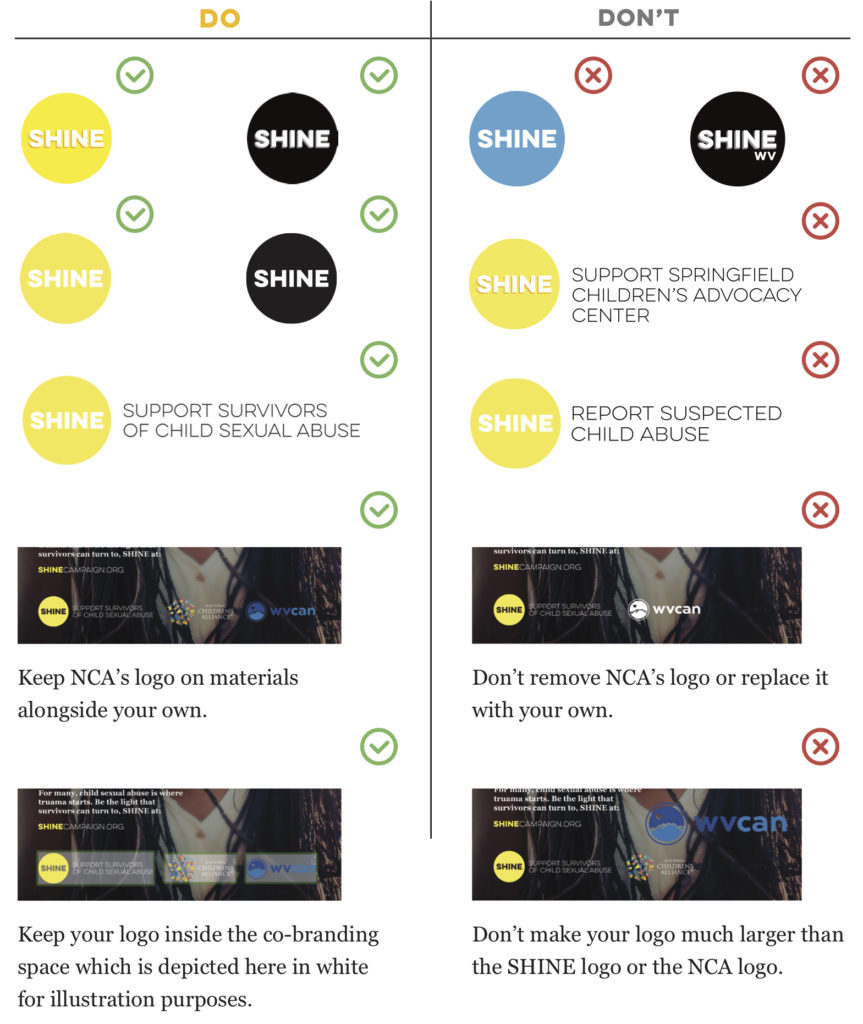
BRAND USAGE GUIDELINES
MESSAGING DOs AND DONT’s
Keep the core SHINE messages intact. Don’t modify them to say other things.
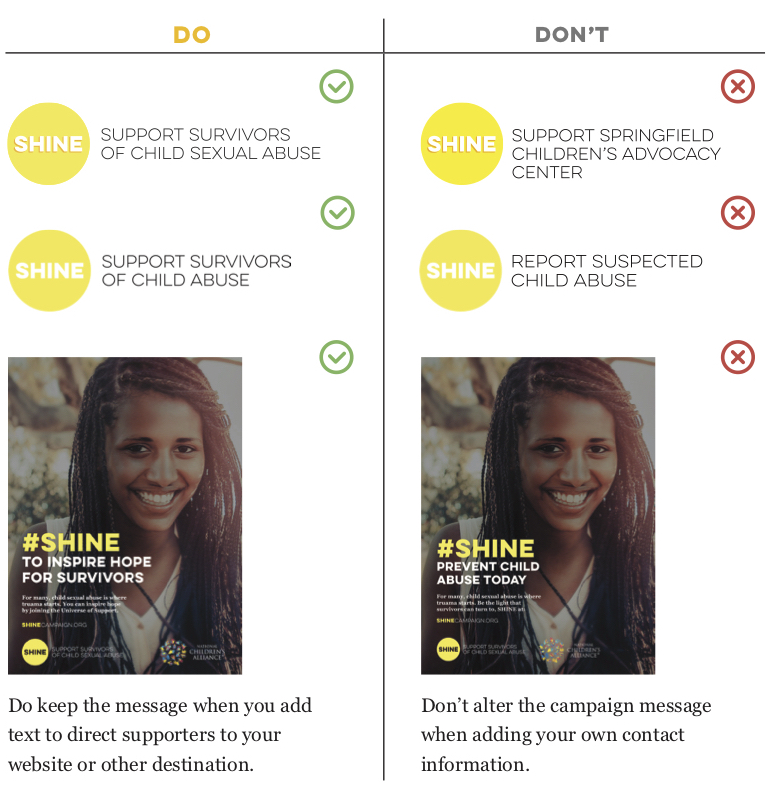
Reaching The Media
Social media has changed the world, but traditional media is still the shortest route to get the most attention for our cause. In order for the SHINE Campaign to fully succeed, it’s critical that your organization is able to gain the media’s attention around SHINE. To have a high-performing, integrated communications plan, we have to not only know when and how we’re implementing and executing our campaign materials, we also need the media in our coverage area to help tell the campaign’s story and, in doing so, improve the campaign’s overall reach.
Coordinating media statewide is easier with a Chapter at the helm. Both templated resources and coordinated statewide media buys can be cheaper and easier at the Chapter level. Also, Chapters may have relationships with media companies, billboard owners, media outlets, etc. There’s a strong case for your leadership of the media effort. Remember—a campaign’s success is measured by the number of heads we turn, by the number of people we engage with, and by the number of conversations we start. We can’t do this work without the media’s help.
In this section, learn how to identify coverage areas and opportunities—whether you’re in a small state or a big one, here’s who to speak with at media outlets, best practices for communicating, and what to say in your pitch.
WHY IS THE SHINE CAMPAIGN NEWSWORTHY?
Simply launching a new awareness campaign isn’t enough to make it deserving of press coverage. To convince a reporter to want to cover your SHINE Campaign activities, you must be able to prove to them why it is so important that they and their readers pay attention to the work you are doing right now. There needs to be a level of immediacy when it comes to turning heads.
DEVELOPING AUDIENCE APPROPRIATE MESSAGING
Here are some messaging components to consider to help you answer that question:
At a time when disclosures of sexual abuse and harassment are becoming mainstream, child sexual abuse still lives in secrecy and shame.
Through a new national campaign—the SHINE Campaign—we at [NAME OF YOUR ORGANIZATION] are changing the conversation around child sexual abuse.
For too long, we as a society have allowed this issue to live in the shadows. By not talking about it, we have perpetuated a culture that isolates survivors and their families, and deterred potential advocates from engaging with the issue. It’s up to all of us to end that stigma and it starts by talking about it.
The SHINE Campaign is newsworthy because it is taking a revolutionary approach to changing the conversation by giving everyday people an accessible way to become advocates for children and support the work of Children’s Advocacy Centers.
And we’re doing that by [List off your campaign’s efforts, any events you’re holding and so on]
WHAT DO I SAY?
So now that we’ve done our homework—we’ve created a ranking list of who to call and we’ve familiarized ourselves with each news organization’s reporting—we’re now ready to start picking up the phone and pitching a story on SHINE.
But, wait. What are we going to say?
Before you call any news organization, this is the most important step to consider. The language that you use to pitch your story to an editor or reporter is a make or break between whether or not they bite or pass on a story.
When it comes to the SHINE Campaign, here are some key messages and themes to consider when building your pitch:
1ST THEME: THE TIME IS NOW
Your pitch must emphasize immediacy. You need to make the reporter or editor feel that they cannot wait or hold on this story. It has to be told now.
“Through the SHINE Campaign, we are changing the conversation around child sexual abuse, and this is why this work cannot wait. This is why SHINE is so important.”
2ND THEME: YOU CAN HELP US END THE STIGMA
We need to make that journalist feel that they, too, have a very important and critical role in ending the stigma of shame and secrecy associated with child sexual abuse.
“For too long, we as a society have allowed this issue to live in the shadows. By not talking about it, we have perpetuated a culture that isolates survivors and their families, and deterred potential advocates from engaging with the issue. It’s up to all of us to end that stigma, and it starts by talking about it.”
3RD THEME: THE SHINE CAMPAIGN IS DOING SOMETHING THAT HAS NEVER BEEN DONE BEFORE
To really make a journalist perk up, we need to convey to them that this idea, this awareness campaign, is a novel idea and it’s the first of its kind. If there is a new, original quality to the story you want told, that will catch the attention of any good journalist or editor.
“Through the SHINE Campaign we are encouraging everyday people to SHINE in support of survivors– to be the light that lets kids know they can come out of the shadows. Through SHINE’s online “Universe of Support,” we have created national platform that connects survivors and supporters and allows them to tell their stories, feel empowered, and inspire hope.”
4TH THEME: HERE’S WHAT WE HAVE TO OFFER
Do you have an event you’re hosting to bring awareness to the campaign? Is there an upcoming press conference they need to attend? Do you have an exclusive interview with a survivor?
Not only do you have to sell the reporter/editor on why they need to be talking about the SHINE Campaign now, it always helps your cause if there is a tangible thing to point to. Simply by holding an event, you are creating something that is newsworthy.
SAMPLE PITCH
So, now that we’ve answered these four themes, it’s time to put it all together in a pitch. Here’s an example of a strong pitch:
“Hi, my name is [your name & role in your organization].
I’m calling because we’re launching a new campaign, called SHINE, on DATE. It’s part of a national movement of Children’s Advocacy Centers to change the conversation around child sexual abuse.
For many, child sexual abuse is where trauma starts. While as many as 1 in 8 children experience sexual abuse, the issue exists in the shadow of shame and secrecy. That stigma has perpetuated a culture that isolates survivors and their families, and deters potential advocates from engaging. It’s up to all of us to end that stigma and it starts by talking about it.
Through this new SHINE Campaign, we are bringing the conversations around sexual abuse out of the shadows. By encouraging everyday people to SHINE in support of survivors—to be the light that survivors can turn to—we are making it easier for people to become advocates, and we are helping kids SHINE again.
We hope that you too will help us break this cycle of secrecy and shame and help to empower survivors.
To help launch our new campaign, we’re going to be holding a [include details of your event, or press conference or personal story you want to offer].
Thank you so much for your time, [your name]”
As soon as you get off the call, follow it up by sending a thank-you email to the person you spoke to and include your press release in the email.
If you are following up with an individual reporter, send a separate email with the press release included to the organization’s editors. This will ensure that even if the story falls off the reporter’s radar for whatever reason, the editors are well aware of what is going on.
If you haven’t heard from the reporter or editor you spoke with in a few days, follow up with them. It can just be a friendly check-in call to say that you appreciated talking with them and wondered if they had more time to think about the story.
SAMPLE PRESS RELEASE
Unless it really is breaking news, you’ll most likely want to send a press release along with a personal note—after you’ve called. Most of the time, your press release should be something you come up with to promote a specific event or action your Chapter and your members are taking. Again, launching a campaign is not in and of itself
Become the Expert
As you build relationships with your local reporters, keep them informed about your statewide and national trends. You can become the expert in your community on child abuse and related matters so they contact YOU when they have questions or want information related.
TIPS TO GETTING THE COVERAGE YOU NEED
Here are some things to always, always do.
Always Follow-Up
Calling a reporter or editor once is not enough, and it’s not enough to just send one email. Reporters are busy people. Try to remind them that you’re there and that now is the time for them to pay attention to the SHINE Campaign.
Be Flexible and Available
A reporter may call you for an interview when you’re not in the office. Be prompt in returning their call, given that they are on a deadline. And remember to be available after you’ve reached out to them or sent a press release. They will likely follow up with you that same day. Be on the lookout.
Be Careful of Dates
Is the campaign falling around a major holiday? Is there an election going on? Be aware as to what’s happening in the general news cycle. If you try to pitch your story three days before the Fourth of July chances are reporters are going to be way too busy for your pitch to really catch their attention. Don’t call at an obviously busy time.
Mondays are typically slow news days, as editors are coming back from the weekend. Call on a Monday morning and pitch your story. If it isn’t around a busy time, the editor/reporter will be thankful you did.
Write an Op-Ed
Getting coverage helps you get public awareness. An op-ed or letter to the editor helps you shape opinion. Even if you’ve secured press coverage from a number of news organizations, submitting an op-ed to the opinion editor of your local newspaper is a good idea. Be sure to have the executive director of your organization author the op-ed.
Op-eds provide a great opportunity for executive directors to share a personal story or aspect that otherwise wouldn’t be widely known by the general public. It allows you to add to the conversation, and it provides another unique opportunity to talk to readers about why the work of SHINE—changing the conversation around child sexual abuse— is so important.
SAMPLE OP-ED
When submitting an op-ed, you should think about things happening in the news in your community, and respond quickly to use those new items as a way to raise awareness through an opinion piece that positions you as a thought leader. For example, a high-profile abuse case or a hometown celebrity sharing a personal story related to our cause might be a good time to submit an op-ed.
When submitting an op-ed, you should think about things happening in the news in your community, and respond quickly to use those new items as a way to raise awareness through an opinion piece that positions you as a thought leader. For example, a high-profile abuse case or a hometown celebrity sharing a personal story related to our cause might be a good time to submit an op-ed.
That said, do it quickly. Most of the time, you’ll want to have a sample op-ed lying at the ready, then when a situation comes along, you can quickly rewrite it to fit the moment in the news cycle. Aim to submit an op-ed within 24 hours after big breaking news.
Alternatively, use your judgment to submit an op-ed that covers an ongoing local issue from an angle that hasn’t gotten much attention. More on these opportunities under the next heading.
Finally, read your local newspapers and watch local stations. If they’ve got a story wrong, or got it sublimely right, or if you think more context or information is needed, and you’re the right person to comment, submit a letter to the editor.
A word of caution: many newspapers have informal practices or even specific policies against publishing more than one opinion piece or letter from a single author in a given period of time, usually every three or every six months. Don’t try to run a piece on every little issue that comes up—wait for the important ones, then strike. But, if you don’t get your piece published, feel free to try again sooner if another opportunity arises.
Download a Sample SHINE op-ed.
Use the template to promote an event or edit it to make a press release about your own newsworthy happenings.
Social Media Messages & Tools
Social media will be key in spreading the message of the SHINE Campaign and taking it beyond just brand recognition and sound bites, to broader and deeper education and engagement. Different social media platforms will enable the campaign to reach audiences of varied demographics, geography, and roles—from the general public, advocates, and potential donors, to legislators and policy makers. Social media initiatives will be instrumental in making taking SHINE beyond a PSA campaign to a true conversation changer.
This section of the toolkit will outline the different social media strategies and tactics that will be used, both from the NCA level and by Chapters and CACs. The social media strategy will consist of two components: a “pull” and a “push”. The “pull” will be the effort to gain interest and followers for the campaign; the “push” will be messages, information, and asks that we will want to share with SHINE followers.
THE “PULL” STRATEGY
People are naturally drawn to personal stories. Stories can create interest, encourage empathy, and educate in ways that resonate on a deeper, more memorable level than other kinds of presentation. We believe that to change the conversation about child abuse, we must first start conversations—with real people, sharing their personal thoughts and experiences, and asking readers on social media to reflect on these first- hand narratives.
Our conversation starters will be real adult survivors, their friends, and their family members, each with their own story of hope and healing, and their own thoughts on how we as a society can shine a light on child abuse and support survivors. Their thoughts will be shared along with natural, emotive, connection-building photographs, created by professional photographers both on Instagram and Facebook.
SHINE Social Platforms
Our model for this type of storytelling is the great Humans of New York Facebook page. We suggest looking at it and reading some of the stories; this part of the campaign will follow a similar format. These stories will be the feature of our specially created Facebook and Instagram pages. You can find our Instagram page @whyweshine and our Facebook page at www.facebook.com/SHINEcause.
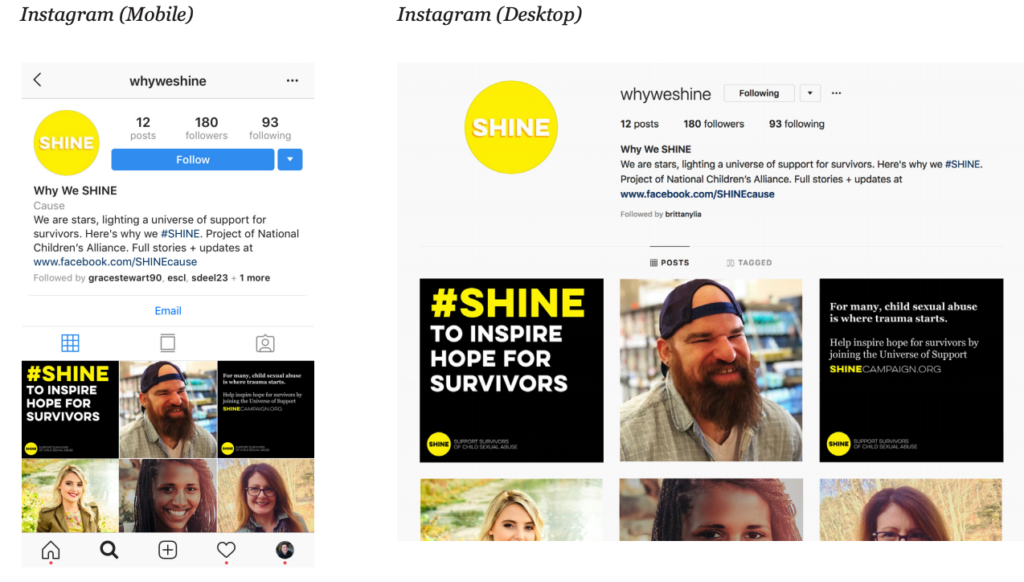
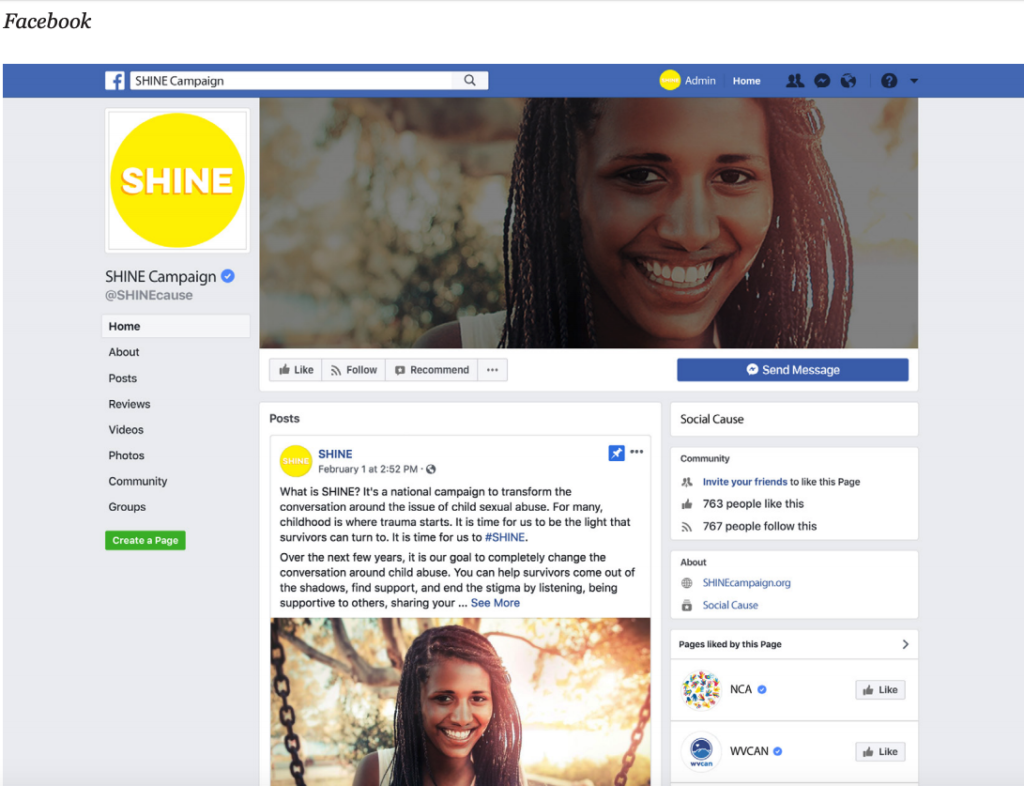
How CACs Can Contribute SHINE Stories
We are looking for adult survivors who are willing to share their stories of hope and healing, and in many cases, CAC staff will be our best sources for identifying these survivors and connecting them with us. CACs will also be instrumental in ensuring that the adult survivors who might potentially share their stories on this platform are in a good place mentally to do so, and have the appropriate support during and after their interaction with us. If you know of an adult survivor who might be interested in sharing their thoughts to help change society’s views, send a message to any of the SHINE social accounts or email shine@nca-online.org and we will work together to make the connection. We will be providing more specifics on this as we continue the rollout of the initiative.
Some simple but powerful steps that CAC staff can take to support the SHINE social media efforts can include:
- Follow our Facebook and Instagram accounts.
- Like, comment on, and share our posts to spread the stories and messages far and wide; the success of the campaign depends on reaching as many people as possible.
- Share the posts on both your CAC pages and your personal pages/accounts.
- Utilize SHINE hashtags and sample Tweets, which will be sent out by NCA.
Sharing Your Stories
You can send us photos and stories you’d like to see shared on the main SHINE
Facebook page and the @whyweshine Instagram account. CAC leaders will of course know how to approach adult survivors with sensitivity, but we still ask that you review our Guide to Telling Your SHINE Story. While the Guide is written to the audience of the survivor telling their story, you as the interviewer should become well-versed with it and use the sample interview questions and the advice in the guide as the basis for your interview. The Guide includes a legal photo and story release, which your SHINE storyteller should sign and email to shine@nca-online.org. Share the Guide with anyone who will be involved in the storytelling or the photo shoot, especially if they do not have experience talking with survivors.
Download A Guide to Telling Your SHINE Story.
Please feel free to pitch stories or submit photos and stories, whether your own or someone you know who has agreed to be featured, by sending a message to either page or by emailing shine@nca-online.org. While we can’t share every photo or story from survivors, here are some tips that will help your submissions shine:
- Make sure your interview subject is an adult survivor. We cannot accept stories from child survivors, as children who share their survivor stories may not understand the implications of sharing them publicly.
- Use the guided questions found in the Guide to Telling Your SHINE Story.
- Make sure the story is consistent with the campaign tone found on page 7 of
this toolkit (e.g. hopeful, optimistic, human). - The story is focused on the hope for survivors found in pledging to support one another and child victims.
- The story is not focused on the abuse narrative, the trauma, or the abuser.
- Utilize SHINE hashtags and sample Tweets, which will be sent out by NCA.
- The photo is professional quality, but does not need to follow any certain kind
of composition or other convention. See the Humans of New York page for
examples. Please also see our Gathering SHINE Stories: Photography Tips for
Beginners Guide. - Photos do not need to feature the face or other identifying features of the
survivor if the subject does not want to be seen. Held objects, angles that
obscure facial features, meaningful tattoos, and other things may be used in
place of a portrait.
Selfies: More Than Just A Pretty Face
You can easily create SHINE branded “selfie signs” and share them online. People anywhere can download and print colorful signs with your logo, the SHINE brand, and a message about “Why I Choose to #SHINE” that challenges viewers to participate in the trend. Giving Tuesday’s #UnSelfie campaign generated hundreds of thousands of posts featuring smiling faces of real charity supporters, driving awareness and increasing giving. Creating a moment to show your faces to the world can set off a wave of support. The only limit is your creativity! Costumes, props, famous backdrops, and lots of friends are welcome.
We Need Photographers!
NCA is building a national network of portrait photographers who may be able to help take professional-quality photos pro bono, but we can always use your help. Many of us know of professional or hobby photographers in the community. Please tell them about the SHINE project and ask if they can help by taking photos. NCA will always tag and credit photographers for images shared through the SHINE accounts if desired.
Learn to Take Photos!
It’s often easier to take high-quality photos than to find a professional to do it for you. Here’s a link to a guide on how to take high-quality photos. You can interview the subject and capture his or her great personality yourself if that’s easier!
Download our Gathering SHINE Stories: Photography Tips for Beginners Guide.
THE “PUSH” STRATEGY
While the stories of @whyweshine will both draw people to the campaign properties and educate them through connection and reflection with real survivors, they will also serve as a springboard for further endeavors to educate the public. Fact sheets, infographics, news articles, and links to outside resources will be shared on the site as corollaries to various themes that will arise from the stories. Some of the themes will include:
- Delayed disclosure
- Grooming
- Polyvictimization
- Long-term effects of abuse
- Handling disclosure
- Reporting
- Being trauma-informed
- Resilience factors
- Support for adult survivors
- Prevalence of abuse across races, religions, cultures, socioeconomic classes, and geographies
The pages can also be used as a forum to educate followers about the CAC model, highlighting events and accomplishments across the country, and featuring stories from CAC staff about their own experiences supporting survivors.
Ultimately, we believe that connecting these three key pieces – personal stories, child abuse awareness and prevention information, and awareness of the work of CACs – will bring about a deeper and broader understanding of child abuse prevention and healing, and promote support for CACs as conduits of the healing process.
How You Can Utilize SHINE Social Media
Sharing content from SHINE’s social media accounts is a great way to raise awareness among your own communities, as well as potentially gain followers. You can also piggyback off the SHINE themes in your own outreach initiatives. Some possible uses can include:
- Use SHINE as the theme for your Child Abuse Prevention Month initiatives in April.
- Use share and use posts from @whyweshine and the SHINE Facebook page as a springboard for narrative for Facebook fundraisers.
- Connect stories and informational materials from the SHINE pages to the work and accomplishments of your own CAC.
- Gain recognition for your statewide campaign by submitting member and supporter stories to @whyweshine.
Digital & Physical Campaign Assets
The first step to building the SHINE movement is visibility. The bright, hopeful campaign visuals are eye-catching and will direct audiences in public spaces to learn more and engage with the growing movement—and help you activate and organize the SHINE movement within your local community. Your SHINE Campaign is all about deepening relationships and letting your activists carry the message to their networks, but first, you have to get their attention.
In this section, learn how to use the SHINE brand, messages, and images, then access, customize, and deploy SHINE messages in your community. There are even some assets NCA can provide directly, plus tips on how to get pro bono or “low-bono” in-kind help from local businesses who may want to partner and help this movement grow.
EASY DESIGN TOOLS
If your organization doesn’t have access to design software or a designer who can help you customize your materials, Canva.com is an online software that is available free to nonprofits. Because Canva is simple to use (even for beginners), we have designed jpgs you can drop in to different formats in Canva to make customization accessible. Just don’t forget to follow the branding guidelines found beginning on page 13 of this document.
Click here to access posters, billboards, and social media designs ready for use in Canva.
Canva Screenshot (Click the picture to visit Canva.com)
ADVANCED DESIGN PROCESS
If your organization wishes to access truly customizable source files for the SHINE art, or are working with a professional designer, please reach out to NCA at shine@ncaonline.org to discuss. In addition to meeting the brand use guidelines on page 15, you’ll need to send proofs of your art to NCA for review. We’re happy to help, but please plan to add in 48-72 hours turnaround time to secure NCA approval, plus time to make any requested changes to meet brand guidelines.
Finally, if creating your own designs, you will need to secure your own appropriate licensing for fonts, photos, and other copyright-protected elements you use. Free stock photos are available throughout the web, but many of the year-one photos used in the SHINE Campaign must be licensed if you wish to use them in your own custom materials. The official SHINE Campaign fonts must also be licensed. They are not terribly expensive but using unlicensed fonts can be a bad idea. See here for more information on font licensing.
BRANDING
The campaign’s brand means many things, but to sum it up, we can think of it as the total audience experience when interacting with or participating in the campaign. As SHINE grows and evolves, it will become more and more of a physical, personal campaign, campaign adopters will add dimensions to this experience: events, artistic performances and works, meetups, and more.
In the early stages, though, we’ll focus primarily on the visual brand and the messages we use, which can be shared and replicated throughout the digital and physical spaces where CACs operate.
Logos
The basic logos and wordmarks of the SHINE Campaign can be used on all physical and digital assets and form the visual “backbone” of the campaign brand. These assets are downloadable as a package by clicking on each one. Use them on posters, pins, bracelets, keychains, and more.
A Google search for “custom branded items” will bring up many providers of affordable promotional items you may wish to have imprinted with SHINE branding to give away or sell to supporters.


Wordmarks (Year One)
These wordmarks include our core year-one message: support survivors of child sexual abuse. Use these on digital and printed materials. Because our core message will change each year of the campaign strategy, first to broaden to support for survivors of all forms of child abuse, then to focus on support for CACs, we do not recommend using these wordmarks on durable campaign items such as water bottles, shirts, reusable signage, etc.

FONTS & COLORS
For campaign unity, these fonts and colors should be used in all SHINE materials, whether designed in-house or by a freelance designer.
Lulo Clean One
Lulo Clean One Bold should be used for headlines and subheadings. Lulo Clean One should appear only in the campaign wordmarks and should not be used for headlines or body text. Lulo Clean is all-caps only and font tracking should be set -160.


Georgia
Georgia Regular and Georgia Italic should be used for body copy. Georgia Bold can be used as a section headline.

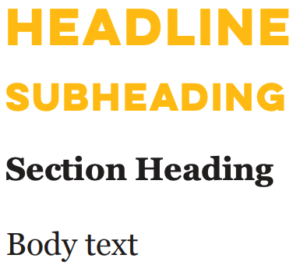
Colors
Color is one of the most important components in a campaign’s brand identity. Color is the first element of a campaign to make an impression. Consistent use of color reinforces the values, message, and memorability of a campaign

PRINT ASSETS
In public spaces, SHINE relies on beautiful, high-impact, large-format images to make a splash and grab the attention of audiences. Here are some template items you can use either readymade (and ready to add your logo), or customizable with photos of champions for children in your community.
When creating customized assets, we strongly recommend working with a professional designer. In your community, you may even be able to get design assistance with your SHINE materials free or discounted by graphic designers who are passionate about our cause.
Posters
Click on the designs below to access poster files.
Placement Examples
These poster files can be printed or deployed digitally. Click on the images to download. Be sure to reach out to local businesses, government agencies, transit authorities, faith communities, and others with access to high-traffic spaces to see what opportunities you can find to place these messages and reach thousands.
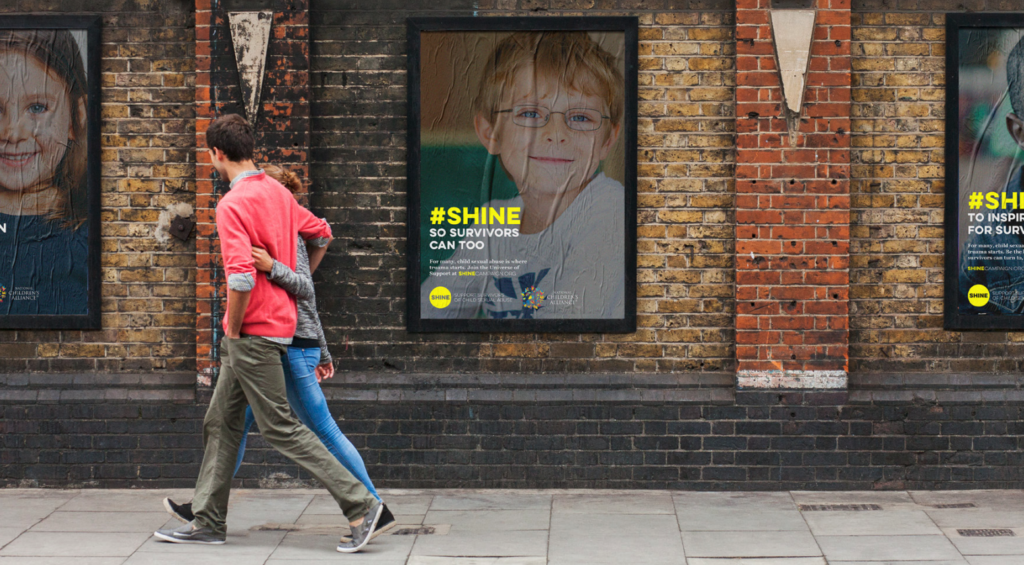
Click on the images to download SHINE billboard files.
Getting Influencers Involved
Artists, celebrities, community leaders, and other figures may be able to help you get your message out louder and clearer than you can alone. It’s a good idea to approach these figures you have connections with if they have been receptive to our issue, and especially if they are public as a survivor or an ally.
As a Chapter, you may have a connection either directly or through a member with statewide influencers. Chapters may have a much easier time reaching state or even national influencers than local CACs may, and you can provide a broader platform. Chapters should also reach out to big urban CACs to see if there are connections to be made there. Save SHINE pins or selfie cards for influencers and take photos of them.
Also, think deeply about the close-knit or interest communities you can reach. A mommy blogger, a local poet, or a classical musician may not be a household name in your state, but they may have a passionate following within their community that can draw the rapt attention of thousands. Brainstorm your connections and don’t be afraid to ask.
WHAT TO ASK FOR
As a CAC professional, you know best how to cultivate these relationships and ask for the things we need to help the common mission. What you’re asking here is for someone to lend their voice.
Social Posts & Stories
For survivors or allies, you can ask them to share a photo and a story that you can post online. Of course, share these stories with the national SHINE social media accounts, too. If you have a local figure with lots of followers, or even a national or international public figure with local roots, you can get a huge amount of exposure for the campaign and for your Chapter.
Events & Benefits
Many influencers can draw crowds, whether through their art, music, leadership, or organizing ability. Propose an idea for an event that highlights the SHINE brand, uses it to raise funds for your Chapter or your members, or creates a social media moment.
Advocacy Help
Your influencers can help with state and federal advocacy efforts. Ask them to join you in visits to the statehouse or to local offices of your representatives in Congress. A little star power can go a long way in getting your legislative goals met, and you might even create a little SHINE excitement among your lawmaker champions by letting them shine their light. Be sure to get great photos with your pins and selfie cards when possible at legislative meetings.
INFLUENCERS IN SMALL COMMUNITIES
In towns, small cities, and rural communities, it may feel like everyone knows everyone, so influencers and civic organizations can have a huge impact. Here are some ways a rural CAC leader developed to help you lay the groundwork for a successful SHINE Campaign effort.
- Develop a two minute “pitch” that you and other board members can use when talking to local influencers. (Use a SHINE story!)
- Make a presentation at your local Rotary Club. If you are not a member, join your local Rotary Club.
- Make a presentation at your local Chamber of Commerce. Send an e-blast to go out to Chamber Members with an invitation to meet with individuals regarding the SHINE Campaign.
- Meet with local ministerial associations.
- Ask to get on the agenda at city council or county commission meetings and offer to meet over lunch with interested individuals.
- Plan an exhibit of art, poetry, music, etc. that highlights the SHINE Campaign and invite public officials, law enforcement, etc. to attend. Recognize team members present, and engage influencers in recognizing both SHINE members and team members.
- Ask to speak at churches/mosques/synagogues about SHINE.
- Send personal emails to local and state politicians announcing the SHINE Campaign and invite them to any function you are planning. Let them know that the media will be in attendance (be sure to alert the media).
- Have talking points available for public officials and other influencers so they can feel confident when addressing any media questions.
- Talk about SHINE and activities you are considering. What do they think? Ask the influencer if they have any other ideas to engage members of the community.
- Ask board members to make personal appeals to influencers they know, and offer to meet over lunch/dinner with influencers and the board member to discuss the SHINE Campaign.
- Develop relationships with adult survivors and ask them to attend meetings with key influencers to tell their stories before making a pitch for support.
- If creating a fundraising goal, do not announce the goal until you have a large portion of the goal (70-90%) in hand. Cultivate donors individually before announcing the campaign. Your goal is not to start from zero, but use the campaign to get the last bit of the way there (and then some).
- Use material from toolkit to develop your local pitch. No need to reinvent the wheel, but be sure to personalize it for your CAC.
